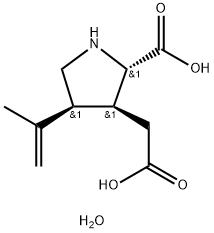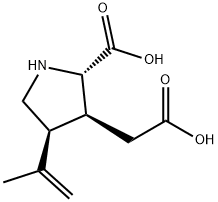KAINIC ACID 2-CARBOXY-3-CARBOXYMETHYL-4-ISOPROPENYLPYRROLIDINE
Synonym(s):2-Carboxy-3-carboxymethyl-4-isopropenylpyrrolidine
- CAS NO.:58002-62-3
- Empirical Formula: C10H17NO5
- Molecular Weight: 231.25
- MDL number: MFCD00150833
- Update Date: 2024-11-19 20:33:22

What is KAINIC ACID 2-CARBOXY-3-CARBOXYMETHYL-4-ISOPROPENYLPYRROLIDINE?
Description
(−)-(α)-Kainic acid is a cyclic analog of L-glutamate originally isolated from D. simplex that has neuroexcitatory activities. It binds to the homomeric kainate receptors GluK1, GluK2, GluK3, GluK4, and GluK5 (Kis = 75.9, 12.7, 32.8, 4.7, and 15 nM, respectively). (−)-(α)-Kainic acid (5 mM) induces calcium influx and membrane depolarization, as well as glutamate release, in rat brain synaptosomes. It induces chromatin condensation and nuclear membrane fragmentation, markers of apoptosis, in primary neonatal cerebellar granule neurons when used at a concentration of 100 μM. Intracerebroventricular administration of (−)-(α)-kainic acid induces convulsive behavior in rats (ED50 = 0.51 nmol/animal) and induces seizures in mice with a 50% convulsive dose (CD50) value of 0.39 nmol/animal. It has been commonly used to induce seizures in rodents.
The Uses of KAINIC ACID 2-CARBOXY-3-CARBOXYMETHYL-4-ISOPROPENYLPYRROLIDINE
Kainic acid is used to study mechanisms of excitation-induced apoptosis and epilepsy.
The Uses of KAINIC ACID 2-CARBOXY-3-CARBOXYMETHYL-4-ISOPROPENYLPYRROLIDINE
Kainic acid monohydrate has been used:
- As a convulsant to induce epileptogenesis and epilepsy in mice.
- To stimulate in vitro excitotoxic trauma in spiral ganglion neurons on inner hair cells.
- To induce seizures in rat model.
- To induce status epilepticus in adult male Wistar rats.
What are the applications of Application
Kainic acid monohydrate is a potent excitatory amino acid agonist
General Description
Kainic acid is an agonist for kainate-class ionotropic glutamate receptors. Kainate receptors directly gate ion channels and are generally excitatory. Excess stimulation by Kainic acid induces neurocytosis (apoptosis) and epileptic seizures.
Biochem/physiol Actions
Kainic acid monohydrate is an agonist at the kainate class of ionotropic glutamate receptors, which induces seizures and neurodegeneration in vivo and is used to induce experimental epilepsy in rodents and study the mechanisms of excitation-induced neuronal apoptosis.
Properties of KAINIC ACID 2-CARBOXY-3-CARBOXYMETHYL-4-ISOPROPENYLPYRROLIDINE
| Melting point: | 250-252°C |
| RTECS | UX9665250 |
| storage temp. | 2-8°C |
| solubility | H2O: >10 mg/mL |
| form | solid |
| color | white |
| Sensitive | Light Sensitive |
Safety information for KAINIC ACID 2-CARBOXY-3-CARBOXYMETHYL-4-ISOPROPENYLPYRROLIDINE
| Signal word | Warning |
| Pictogram(s) |
 Exclamation Mark Irritant GHS07 |
Computed Descriptors for KAINIC ACID 2-CARBOXY-3-CARBOXYMETHYL-4-ISOPROPENYLPYRROLIDINE
New Products
4-Aminotetrahydropyran-4-carbonitrile Hydrochloride (R)-3-Aminobutanenitrile Hydrochloride 4-AMINO-TETRAHYDRO-PYRAN-4-CARBOXYLIC ACID HCL 4-(Dimethylamino)tetrahydro-2H-pyran-4-carbonitrile 3-((Dimethylamino)methyl)-5-methylhexan-2-one oxalate 1,4-Dioxa-8-azaspiro[4.5]decane 5-Bromo-2-nitropyridine Nimesulide BP Aceclofenac IP/BP/EP Mefenamic Acid IP/BP/EP/USP Diclofenac Sodium IP/BP/EP/USP Ornidazole IP Diclofenac Potassium SODIUM AAS SOLUTION ZINC AAS SOLUTION BUFFER SOLUTION PH 10.0(BORATE) GOOCH CRUCIBLE SINTERED AQUANIL 5 BERYLLIUM AAS SOLUTION 2-Bromo-1-(bromomethyl)-3-chloro-5-nitrobenzene 2-Bromo-3-nitroaniline N-(3-Hydroxypropyl)-N-methylacetamide 3-Bromo-6-chloropyridazine 4-ethyl-3-nitrobenzoic acidRelated products of tetrahydrofuran
You may like
-
 Kainic acid monohydrate 95% CAS 58002-62-3View Details
Kainic acid monohydrate 95% CAS 58002-62-3View Details
58002-62-3 -
 Kainic acid monohydrate CAS 58002-62-3View Details
Kainic acid monohydrate CAS 58002-62-3View Details
58002-62-3 -
 Kainic acid monohydrate CAS 58002-62-3View Details
Kainic acid monohydrate CAS 58002-62-3View Details
58002-62-3 -
 1823368-42-8 98%View Details
1823368-42-8 98%View Details
1823368-42-8 -
 2-(3-(tert-butyl)phenoxy)-2-methylpropanoic acid 1307449-08-6 98%View Details
2-(3-(tert-butyl)phenoxy)-2-methylpropanoic acid 1307449-08-6 98%View Details
1307449-08-6 -
 Ethyl 3-(furan-2-yl)-3-hydroxypropanoate 25408-95-1 98%View Details
Ethyl 3-(furan-2-yl)-3-hydroxypropanoate 25408-95-1 98%View Details
25408-95-1 -
 2-Chloro-5-fluoro-1-methoxy-3-methylbenzene 98%View Details
2-Chloro-5-fluoro-1-methoxy-3-methylbenzene 98%View Details
1805639-70-6 -
 Lithium ClavulanateView Details
Lithium ClavulanateView Details
61177-44-4
